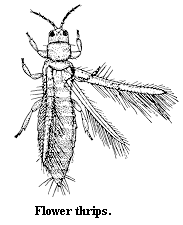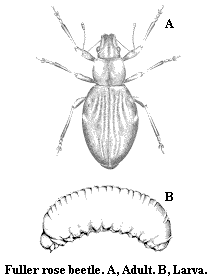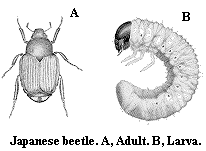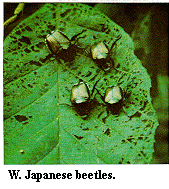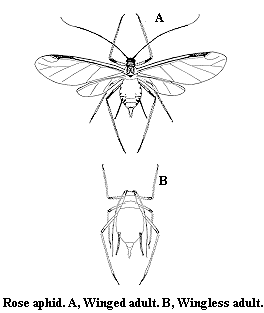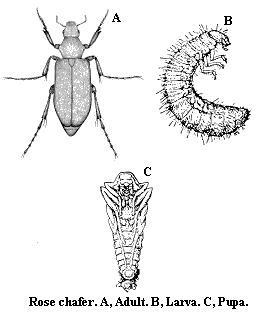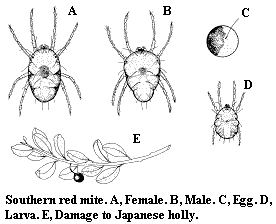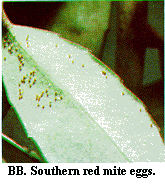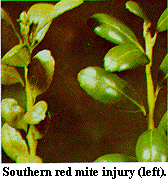Key to Rose Pests
With their showy and fragrant flowers, roses are often used in North Carolina landscapes. Roses as cut flowers are appropriate for any occasion. Fraught with insect, mite, and fungal pests, the challenge of growing a nice-looking rosebush has been euphemistically described as "interesting." About 350,000 roses are handled by Southern nurserymen each year.
- Beetles – Rose petals or leaves consumed by beetles
- Fuller rose beetle – Light-brown to ash-gray beetle with a short snout and a faint white band on each side feeds on leaf margins at night.
- Japanese beetle – Beetle metallic green with brown wing covers and white spots on side, chunky.
- Rose chafer – Beetle buff, fairly slender.
- Flower thrips – Petals distorted and spotted, buds not opening properly; very small, slender, yellowish insects crawling in buds and petals.
- Rose aphid – Small (0.5- to 3-mm), soft, pink or green insects often found in clusters on twigs and buds, where they suck sap from the plant.
- Spider mites – Small chlorotic spots on leaf surface; heavily infested leaves dropping prematurely; tiny, spiderlike animals (spider mites) on lower leaf surface.
- Southern red mite – Mites prevalent in spring or fall, usually dark red with pale legs.
- Twospotted spider mite – Mites prevalent in hot weather, usually pale yellow but sometimes green, brown, or red.
Flower Thrips
Flower thrips, Frankliniella tritici (Fitch), Thripidae, THYSANOPTERA
DESCRIPTION
Adult – The small (1.25-mm), winged flower thrips is yellowish brown to amber with an orange thorax. The male is slightly smaller and lighter in color than the female.
Egg – The flower thrips' delicate egg is cylindrical and slightly kidney shaped with a smooth, pale or yellow surface.
Larva – The tiny young thrips is lemon yellow, resembling the adult except for its lack of wings.
BIOLOGY
Distribution – Flower thrips were first described in New York in 1855. Evidently because of their small size, they are carried by frontal wind systems over large areas. They have been trapped at altitudes of 3,100 m (10,000 ft). In the summer they are found throughout the eastern United States, the maximum rate of migration taking place in the first week of June.
Host Plants – Flower thrips have been collected from 29 plant orders, including various berries, cotton, day lilies, field crops, forage crops, grass flowers, legumes, peonies, privet hedges, roses, trees, truck crops, vines, and weeds. They seem to prefer grasses and yellow or light-colored blossoms. Roses are most susceptible in June.
Damage – Flower thrips are one of the most numerous insect pests of ornamental crops. In warm periods, this species often flies in late afternoon in swarms of tiny, orange insects. "When they light, they bite," as the old saying goes; and thrips do bite people, causing a noticeable stinging sensation. Their large numbers account for considerable and rapid damage to flowers, especially those with light-colored petals. Yet thrips contribute to pollination, an unexpected benefit!
Life History – Flower thrips are generally found at the base of the flower's petals. They reproduce throughout the year in North Carolina, with the majority of their 12 to 15 generations occurring during the warmer months. Newly emerged females begin to lay eggs within 1 to 4 days in summer and within 10 to 35 days in winter, reproduction being much faster in warmer weather. In summer the adult stage is reached in about 11 days. Flower thrips pass through egg, two larval, prepupal, pupal, and adult stages. The eggs are inserted into flower or leaf tissue, and the prepupal and pupal stages are spent in the soil. In summer flower thrips may live 26 days, though overwintering thrips may live all winter. Flower thrips can overwinter as far north as North Dakota in grass clumps and other sheltered refuges.
CONTROL
Flower thrips are consumed by green lacewings, lady beetles, insidious plant bugs, and salamanders; yet control of thrips is difficult because of their constant migration from weeds, grass, flowers, and trees. The destruction of old rose blossoms and the application of pesticides at close intervals can help reduce damage. For specific chemical controls, see the current state extension recommendations.
Fuller Rose Beetle
Fuller rose beetle, Pantomorus crevinus (Bohemian), Curculionidae, COLEOPTERA
DESCRIPTION
Adult – This light-brown to ash-gray beetle has elbowed antennae, which arise from its snout, and a white band on the side of each wing cover. About 7 to 9 mm long, this beetle is unusual not only because males of this species have never been found but also because the adults cannot fly.
Egg – An egg mass is composed of 10 to 60 smooth, pale yellow eggs. Each egg is about 1 mm long and oval to elliptical.
Larva – The legless, slightly curved larva has a white body with a pale, almost white, head. When fully grown, it is approximately 9.5 mm long. .
BIOLOGY
Distribution – The Fuller rose beetle has been reported from most areas of North and South America, the Mediterranean countries, Australia, and many Pacific islands. In the United States, it is a common outdoor pest primarily in California and the South Atlantic states. As a greenhouse pest, however, this beetle is more nationally distributed.
Host Plants – In addition to feeding upon many fruit trees and vegetable crops, the adult and larva of this beetle attack an array of ornamental trees and flowering plants. Some economically important hosts of the adult include apple apricot, azalea, begonia, blackberry, gardenia, hibiscus, hydrangea, lily, oak, peach, pear, persimmon, plum, prune, raspberry, rose, and strawberry. The larva feeds primarily on the roots of blackberry, loganberry, raspberry, rose, and strawberry.
Damage – Fuller rose beetles feed on the leaves of host plants, leaving ragged or scalloped edges. They do little serious damage except to the plants' appearance. The larvae, though serious root pests of some plants, do not infest most shrubs.
Life History – For the most part, Fuller rose beetles overwinter as larvae in the soil, though a few adults have been known to survive the winter. Pupation occurs in spring within 10 cm of the soil surface. Adults first appear in July and continue to emerge through November. The adults, which are all females, produce eggs parthenogenetically and deposit them in small masses around the base of the plant or under the calyx of the fruit. Protected with a white, spongy material, the eggs hatch approximately 3 weeks later. The newly hatched larvae work their way down into the soil to feed on the roots. Throughout the growing season, the larvae may be found 8 to 61 cm underground. Only one generation occurs each year.
CONTROL
Fuller rose beetles seldom cause real damage to the shrubs, though the aesthetic value of infested plants may be reduced. In the event of excessive foliar damage, effective pesticides are available. For specific chemical controls, see the current state extension recommendations.
Japanese Beetle
Japanese beetle, Popillia japonica Newman, Scarabaeidae, COLEOPTERA
DESCRIPTION
Adult – The 12-mm-long beetle is shiny metallic green with coppery-brown wings (Figure W). Six small patches of white hairs appear along the sides toward the rear of the insect. The male and female look alike, but the male is generally smaller and has sharper spines on its forelegs.
Egg – The whitish egg is ellipitcal, becoming more spherical as the embryo develops. It has a diameter of about 2 mm.
Nymph – The larva, about 25 mm long when fully grown is a C-shaped, white grub with a yellowish-brown head. It is usually found in a cell underground. There are three larval stages.
Pupa – The pupa is about 13 mm long and 6 mm wide. It may be pale cream, tan, or green depending upon its age.
BIOLOGY
Distribution – Introduced from Japan in 1916, the Japanese beetle has spread from New Jersey throughout the eastern United States. It is a serious pest of many economically valuable plants.
Host Plants – Over 300 plants are known food sources for the Japanese beetle. The adults are particularly fond of roses, and they prefer white and yellow flowers to the darker colors.
Damage – Both the larvae and adults have chewing mouthparts. The grubs consume roots of turf grasses, whereas the adults feed on leaves, buds, flowers, and fruits. Since the adults do not eat the leaf veins, infested leaves become skeletonized. Flowers and buds have ragged edges after beetles have been feeding.
Life History – Japanese beetles overwinter as larvae, pupate in late spring, and emerge as adult beetles about 2 weeks later. Adults usually appear in mid-May. They are gregarious, often feeding together in masses on flowers, foliage, and fruits of plants in bright sunlight. They fly in broad daylight. Populations diminish during August. The female selects poorly drained soil in which to deposit her eggs. She burrows 7 to 8 cm into the ground and lays several eggs at a time, continuing for a period of days until she has laid 40 to 60 eggs. They hatch approximately 2 weeks later. Though a dry summer usually reduces the number of live larvae, a severe decrease in rainfall in the fall or spring hardly affects the population because older larvae are resistant to dry conditions. After entering a quiescent prepupal stage, the larvae pupate. The beetles tend to become well established in areas of grazing, general agriculture, truck crops, and fruit-growing. They are usually not found in heavily forested land. Though it takes 2 years for a generation to develop in the beetles' northern limit, 1 year is required in most areas.
CONTROL
Insecticides will not completely protect roses, which unfold rapidly and are especially attractive to beetles. When beetles are first noticed on roses, buds should be nipped and the bushes sprayed to protect the leaves, then when the beetles become scarce, the bushes can be allowed to bloom. To protect a limited number of rose blooms, nets or perforated bags can be tied around the blossoms. For specific chemical controls, see the current state extension recommendations.
Rose Aphid
Rose aphid, Macrosiphum rosae (Linnaeus), Aphididae, HEMIPTERA
DESCRIPTION
Adult – This large (2.5-mm) aphid has long, dark legs and honey tubes. Its body is pink, purplish, or green. Adults may have wings.
Egg – The egg has not been described.
Nymph – Nymphs resemble wingless adults (except they are smaller than adults). Both green and pink forms occur in the nymphal stages. .
BIOLOGY
Distribution – Originally described from Europe, the rose aphid is now found throughout the United States except in the arid Southwest.
Host Plants – Rose aphids feed on rose and sometimes on pyracantha.
Damage – Rose aphids feed on tender shoots and buds. High populations reduce quality and quantity of flowers.
Life History – The entire life cycle may be spent on one host plant. Reproduction is by birth of live young throughout the growing season. In late fall, a generation of males and females is produced. These mate, and females then lay eggs on the rose canes. The eggs are the overwintering form. In spring as new growth resumes, the eggs hatch and the tiny nymphs begin to feed.
CONTROL
Parasitic wasps, lady beetles, and green lacewing adults and larvae prey upon the rose aphid. Except in cool weather, these biological control agents may keep the rose aphid population in check. For specific chemical controls, see the current state extension recommendations.
Rose Chafer
Rose chafer, Macrodactylus subspinosus (Fabricius), Scarabaeidae, COLEOPTERA
DESCRIPTION
Adult – The adult rose chafer is a tan, slender beetle with a reddish head and long, spiny, reddish legs (8 to 13 mm in length). The female is somewhat more robust than the male. The wings do not quite cover the abdomen.
Egg – The oval, shiny, white egg is 1 to 2 mm long.
Larva – The larva resembles a white grub (May beetle larva) but is smaller (up to 18 mm in length) and more slender.
Pupa – The light yellow-brown pupa is 16 mm long and has the last larval skin clinging to the posterior.
BIOLOGY
Distribution – Rose chafers are found primarily in the northeastern United States, but they also occur south at least to North Carolina and west to Colorado.
Host Plants – Rose chafers seem to prefer the flowers of roses and peonies, new grapes, and leaves of grapes. They will feed on apple, cherry, dahlia, elder, elm, foxglove, geranium, hollyhock, hydrangea, pear, poppy, Virginia creeper, and wisteria. The grubs feed on the roots of turf, weeds, and nursery stock.
Damage – Rose chafers are remarkable for the variety of hosts upon which they feed and because they are poisonous to chickens and birds when eaten. Rose chafers consume petals of roses and other flowers. The foliage of various broadleaved plants is skeletonized. Rose chafer grubs feed on the roots of grasses, weeds, and nursery stock.
Life History – Rose chafers appear in late May or early June and feed on roses, peonies, and sometimes iris and other flowers. They also feed on grapes and at times may damage elms, birches, and other trees severely. The adults live for about 4 to 6 weeks. Eggs are laid about 15 cm deep in sandy or grassland soil, and they hatch in 1 to 3 weeks. The eggs are laid in groups of 6 to 40, but each egg is deposited in a separate cavity. The larvae feed on the roots of turf and ornamental plants. They apparently move down into the soil for moisture. The larvae spend the winter deep in the soil. In early spring the grubs migrate upward and pupate in early May in earthen cells. There is one generation per year.
CONTROL
Prize rosebushes may be protected by a cheesecloth frame while the beetles are in flight (most of June). Handpicking the beetles may help. Rose chafers should not be fed to poultry or family pets; these insects are poisonous (apparently because they contain cantharidin, a blistering agent). For specific chemical controls, see the current state extension recommendations.
Southern Red Mite
Southern red mite, Oligonychus ilicis (McGregor), Tetranychidae, PROSTIGMATA
DESCRIPTION
Adult – The female adult is about 0.38 mm long and resembles a small spider. The abdomen is dark reddish or brown; the cephalothorax is pinkish or red. There is also a pale midstripe. The male resembles the female but is smaller (0.3 mm) and usually dark, lacking the pink or red color.
Egg – The brownish to reddish egg is depressed with a central stipe or hair (seta) (Figure BB).
Larva – The larva is nearly white with a few reddish dots.
Nymph – The nymph is similar to the adult male in color.
BIOLOGY
Distribution – The southern red mite was first reported on hollies at Batesburg, South Carolina, in 1917. This spider mite, at times exceptionally destructive, is a common and serious pest throughout the eastern United States and in California.
Host Plants – Southern red mites seem to prefer azaleas, camellias, and hollies. These mites have also been recorded on clethra (sweet pepperbush), cleyera, elaeagnus, eucalyptus, eugenia, grevillea, hibiscus, juniper, kalmia, oxalis, photinia, pyracantha, rhododendron, rose, and viburnum. Plants in the Ericaceae and Aquifoliaceae seem to be especially susceptible.
Damage – Southern red mites feed on the lower leaf surface, causing mesophyll collapse. Infested leaves turn gray or brown and may fall from the shrub prematurely (Figure CC). If uncontrolled, southern red mites may hasten the death of a heavily infested plant.
Life History – Southern red mites pass through a larval stage and a series of nymphal stages before they mature into adults. They usually feed on the lower surfaces of woody ornamental plants. When populations are high, however, these mites will feed on the upper surfaces as well. Being "cool weather mites," they reproduce rapidly in spring and fall and become almost inactive in winter and summer. As a result, when the populations of predaceous insects and mites are active in summer, populations of southern red mites are rather insignificant. Southern red mites evidently overwinter as eggs.
CONTROL
Because southern red mites are most active in cool weather, infestations should be treated at the end of summer or winter for maximum effectiveness. Multiple foliar applications of proper miticides at 2-week intervals may be needed to obtain desired control. For specific chemical controls, see the current state extension recommendations.
Publication date: Jan. 1, 1993
Reviewed/Revised: Aug. 9, 2024
AG-189
Other Publications in Insect and Related Pests of Shrubs
N.C. Cooperative Extension prohibits discrimination and harassment regardless of age, color, disability, family and marital status, gender identity, national origin, political beliefs, race, religion, sex (including pregnancy), sexual orientation and veteran status.

